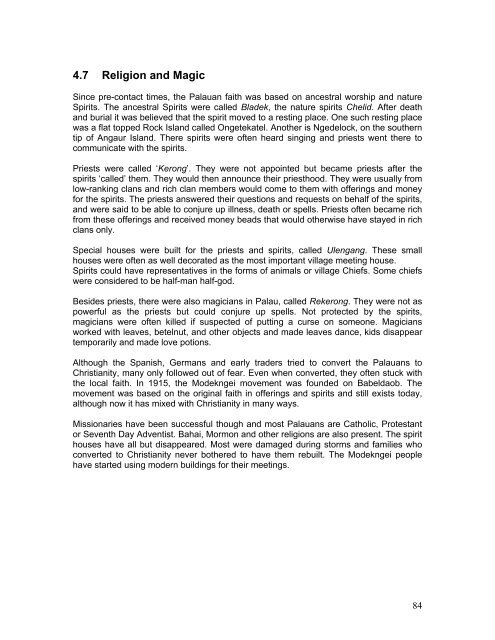KOROR STATE GOVERNMENT MARINE TOUR GUIDE ... - C3
KOROR STATE GOVERNMENT MARINE TOUR GUIDE ... - C3
KOROR STATE GOVERNMENT MARINE TOUR GUIDE ... - C3
You also want an ePaper? Increase the reach of your titles
YUMPU automatically turns print PDFs into web optimized ePapers that Google loves.
4.7 Religion and Magic<br />
Since pre-contact times, the Palauan faith was based on ancestral worship and nature<br />
Spirits. The ancestral Spirits were called Bladek, the nature spirits Chelid. After death<br />
and burial it was believed that the spirit moved to a resting place. One such resting place<br />
was a flat topped Rock Island called Ongetekatel. Another is Ngedelock, on the southern<br />
tip of Angaur Island. There spirits were often heard singing and priests went there to<br />
communicate with the spirits.<br />
Priests were called ‘Kerong’. They were not appointed but became priests after the<br />
spirits ‘called’ them. They would then announce their priesthood. They were usually from<br />
low-ranking clans and rich clan members would come to them with offerings and money<br />
for the spirits. The priests answered their questions and requests on behalf of the spirits,<br />
and were said to be able to conjure up illness, death or spells. Priests often became rich<br />
from these offerings and received money beads that would otherwise have stayed in rich<br />
clans only.<br />
Special houses were built for the priests and spirits, called Ulengang. These small<br />
houses were often as well decorated as the most important village meeting house.<br />
Spirits could have representatives in the forms of animals or village Chiefs. Some chiefs<br />
were considered to be half-man half-god.<br />
Besides priests, there were also magicians in Palau, called Rekerong. They were not as<br />
powerful as the priests but could conjure up spells. Not protected by the spirits,<br />
magicians were often killed if suspected of putting a curse on someone. Magicians<br />
worked with leaves, betelnut, and other objects and made leaves dance, kids disappear<br />
temporarily and made love potions.<br />
Although the Spanish, Germans and early traders tried to convert the Palauans to<br />
Christianity, many only followed out of fear. Even when converted, they often stuck with<br />
the local faith. In 1915, the Modekngei movement was founded on Babeldaob. The<br />
movement was based on the original faith in offerings and spirits and still exists today,<br />
although now it has mixed with Christianity in many ways.<br />
Missionaries have been successful though and most Palauans are Catholic, Protestant<br />
or Seventh Day Adventist. Bahai, Mormon and other religions are also present. The spirit<br />
houses have all but disappeared. Most were damaged during storms and families who<br />
converted to Christianity never bothered to have them rebuilt. The Modekngei people<br />
have started using modern buildings for their meetings.<br />
84











